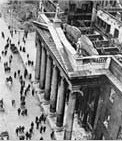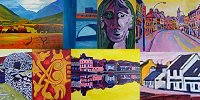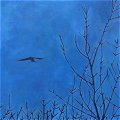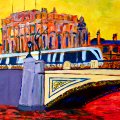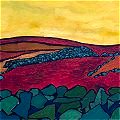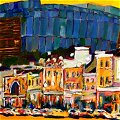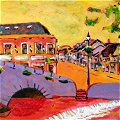Cycling Across America #64
The Tularosa Basin
Part 64 of the Cycle-Across-America series. (Read from the start in Boston or see the full index)

These excerpts are from the transcipts of a journal entry that was taped, so they’re the usual rambling self-indulgent stuff in need of an editor. After several days rest I’m off again, into the extremes of nature and an Indian story or two.
Decision time. It’s a quarter past 7 in the morning on Wednesday 30th October. I’m in Tularosa, New Mexico, and the decision is where to go today.
I wanted to be in Alamogordo, and then it’s 67 miles to Las Cruces across the White Sands, but I’ve an extra 13 miles now from Tularosa, and with a southwest wind of 15mph.
There’s nothing in between so I can’t afford to get stuck. I could play it safe and have a day where I just do 13 miles down the road and do a lot of sightseeing. There’s the Space Center in Alamogordo. Just outside it is Dog Canyon -oh that’s quite a bit actually.
That said, the winds are going to be even stronger tomorrow so 67 miles then might not be any easier than 80 miles today. I’d want to get moving fairly soon. I also have a puncture to fix.
The previous day my Ruidoso host had taken me and the bicycle in the truck, after we had lunch with his wife, and dropped me off at the point he had picked me up several days earlier:
We are about 100 yards past it, he says to me, to make sure absolutely sure we didn’t leave a gap on my route.
And I loaded up the bike, shook his hand, and said goodbye. He said he was going to miss me; I said likewise. I’d got very comfortable there in the last few days. And I really enjoyed their company.
Now I was immediately into a big wind as well as climbing. So I was only going about 8 miles an hour. Then down to 7, then 5. I settled on 5 to 4 and a half miles an hour.
I went past the equine sculpture by Dave McGary. 8 horses which are one and a half times lifesize. I went past the racecourse of course which actually looked quite unimpressive to be honest. It was an oval track, a dirt track, a low stand on the far side. And it looked like it was just dug out of the earth so it looked like a temporary mine.
Passed the village of Ruidoso Downs which is an elevation of 6,900 it says at that point. And then Ruidoso. The elevation of the sign there is 6,875 but it goes up to 7,200 as you go up the main street of Sudderth.
I was going 4 and a half to 5 miles an hour for all this stretch. At times I was at a standstill from the wind. It was ferocious whipping through the pass you’re climbing through. Tons and tons of pine trees. nothing but them.
I entered Otero County, the beginning of the Mescalero Apache Indian Reservation. You see signs like “No hunting, no hiking, no fishing, no cutting trees, no camping, no nothing”. Other signs say the roads are for the Reservation residents only. And indeed those roads aren’t on my map even though they’re paved.
[The rest of this post is continued below the fold]
At the top of Apache Summit there’s a cafe. That’s all that’s there. So I went in because I was very thirsty. And I was giving myself a break from the wind. I was hurting a lot.
Despite feeling very fresh this morning my legs are just very very sore. Because I just had to push the bike no matter what even on some of the more level bits below in Ruidoso. I just had to fight the whole time to move. Plus the injuries from the crash are still there pulling away. You notice that when you get in good condition’ it’s when I get in bad condition there’s so much pain that I don’t notice them.
Tularosa they all refer to as Tulie; Alamogordo is Alamo, and so on.
Anyway, so now I’m going down a steep hill, and the wind was just horrible. It had my hands frozen. I couldn’t get warmth into them. I tried cycling with one hand, and the other one in the pouch but the problem was the wind was so strong you needed to hold on to the bike with both hands.
Sunset tonight is at 5:17pm. Because I’m going west, if it wasn’t for that adjustment for the Daylight Daving Time I’ve actually managed to keep sunset pretty much constant.
So I was going down a very steep hill, the steepest for a long time, and I had to fight my way down. I had to really, really fight. The wind was getting stronger. It was really cold. Windchill. It was freezing my bones, my fingers, and my face was very sore.
I noticed too as I went over the top that it didn’t seem to be long and the pine trees disappeared. I looked at them and they weren’t pine trees anymore; they were bushes. Green bushes and more spread out.
The next town was Mescalero, the business center of the Reservation. I’d wanted to originally stop here and go to the Apache Cultural Center, but it was just so late now because I didn’t get to leave until half one. There was also a church there I’d like to look at and a place recommended to me for eating which I would’ve gone to, but I had to let that all that go and keep fighting down the hill.
At some stage there were bits of walls and they were covered in grafitti, very much like the Tube in London, except it was all Indian stuff, sometimes with writing saying “Indian Power” but mostly with the dancer that they have whose body is painted all black and like a long kind of skirt and crazy head stuff. He features on all the signs of the Reservation, and the ‘Inn of the Mountain Gods’, and you see him around.
In the cafe where I was the only person there chatting to this older Apache, the dancer was hanging on a couple of wall hangings as well. The Apache told me that a couple of Germans had just gone through half an hour earlier on motorbikes, and not so long ago a Russian went through on a motorbike. Not so long ago might have been months or weeks or days. He spoke slowly. There was a Western on the telly which he was watching.
At the town of Bent there was a bend, of all things. And those last 10 miles the wind died down as they said it would do. It got dark as I came into Tularosa. And I also got a puncture on the back wheel. So I rode the last full mile on a complete flat because I didn’t want to spend time replacing it as it would’ve been so dark.
The descent was fantastic for the views. And I kept looking backwards. I got a view of the mountain again when I got far enough away, so I’d gone abut 35 miles. The Sierra Blanca peak. And it looks rather good.
The peak of the Sierra Blanca is over 12,000 feet with the ski resort at 11,000. Yesterday I went there with my Ruidoso hosts. On the way up my ears were popping. We passed a car in a ditch in heavy snow. It was about 10,000 at this point. In the snowstorm we got out to help. Luckily we weren’t needed and I was very happy to get back into the truck. At the next lookout space we turned around and descended. The car in front of us skidded into the barrier before slowing down. Before the snow the views were stupendous. Near slopes of yellow with pine trees and scattered snow, and distant blue peaks and ridges mingling with the clouds. The sleeping elk we’d spotted on the way up was now gone.
But more than the Sierra Blanca peak, all the other hills I saw cycling down, they’re quite dramatic. They’ve got all these kinds of gaps in them, and then lines, and there’s shadows on them. And at the bottom of them they’ve got smaller hills which are like miniature versions of themselves. They are dotted throughout with all these little dots of green. They’ve got horizontal bars of red through them. They’re a yellowish colour.
And there was one called Round Mountain. It’s a steep cone. At the top of it there’s a nipple, shaped rocks at the top, and on that there’s a cross. In the Basin News I read Wilson Thunderhorse respond to an article about the “battle” of Round Mountain:
“Each year Tularosa hosts a grand fiesta. The purpose of this community-wide blow out is to commemorate God’s divine intervention in the Battle of Round Mountain in which Tularosa’s militia was delivered unscratched as they repelled a huge Mescalero Apache war party bent on destroying the small Mexican community. While this creates an excellent opportunity for a party, the fact remains that there never was a battle at Round Mountain, and there wasn’t a war party coming to destroy the ‘village of roses’. An over zealous farmer reported the ‘war party’ which in reality turned out to be some women and small boys, the oldest male was 14, who were hunting rabbits and gathering roots and berries. When Tularosa’s militia saw that their war party was a bunch of harmless women and children, they decided it would be fun to scare the berry-pickers. So the militia shot over the womens heads to make them run home. This is when things backfired. Instead of running the women picked up rocks and sticks and ran the militia to the top of Round Mountain where they held the Tularosans at bay for 3 days. Since the militia wouldn’t fight, the women tired and returned home. Badly shaken from their experience the Tularosans refused to leave their sun-parched perch. They would have died of starvation and thirst had the Mescaleros not told a local monk of the Mexicans plight. The monk was able to convince the militia that it was safe to come down and return to their farms. The Tularosan militia having learned their lesson never again fired on a group of helpless women and children. So ended the Indian Wars of the Tularosa Basin.”
Ok, now as I was descending into Tularosa I could see the mountains in the distance. And it was this fantastic jaggedy blue wall just rising up from the ground, a pure wall running from north to south all the way. And this is the San Andreas Mountains.
It’s stunning because it’s so jaggedy and it does rise up from the flat, because the flat is between me and the mountains, what looks like a sea, or a fog. And that’s White Sands.
All part of the Tularosa Basin, White Sands National Monument, and White Sands Missile Range are the flatlands between the Lincoln Forests or the Sierra Blanca Mountains and the San Andreas Mountains. It’s in here they have a Space Shuttle landing site. They have the firing of Patriot Missiles - this is where they were developed and they do tests still. Actually that’s another problem; if they stop me today for an hour and a half, as it takes to test missiles, I’m in trouble.
There’s also the Trinity site, which is the site of the first atomic bomb test. That’s maybe 50 miles to the north of here but it’s still in the same basin before you get to any roads.
There’s only 2 roads that go out of here basically. From Alamogordo, the one I’m going on, the big one, the 4-lane one to Las Cruces, and a smaller one, US 54 down to El Paso.
It was also sunset at this time so I had a blue sky at the top paling down and changing into a pink and yellow sky. The sun finally went behind the mountains and I was glad it did because for the last hour the glare was blinding. For me and for any motorists that are going to knock me down.
The Mescalero Apache Indian Reservation is one of Geronimo’s places. His descendants still live there. I mentioned this to my host in Ruidosa and she took out a magazine she was responsible for and showed me a photograph of her and his grandson. It’s a fashion photograph. She says he’s a great model. His name is Huston. Huston Geronimo.
Read the Next Entry (#65) in My Bicycle Trip Across America
Read the Previous Entry (#63) in My Bicycle Trip Across America
Read more from my Cycle Across America

 Eolaí gan Fhéile:
Eolaí gan Fhéile: